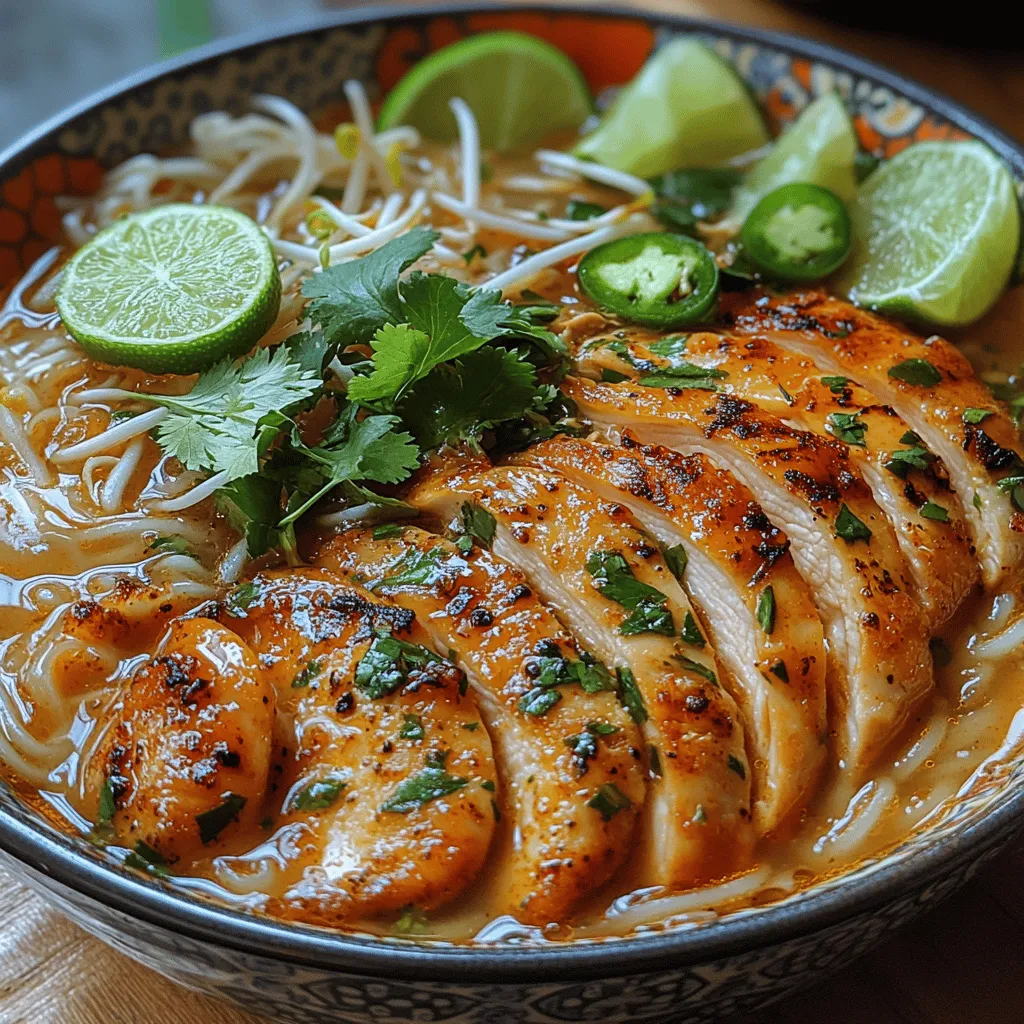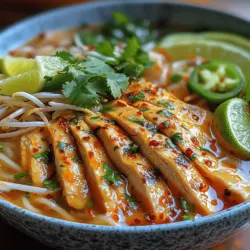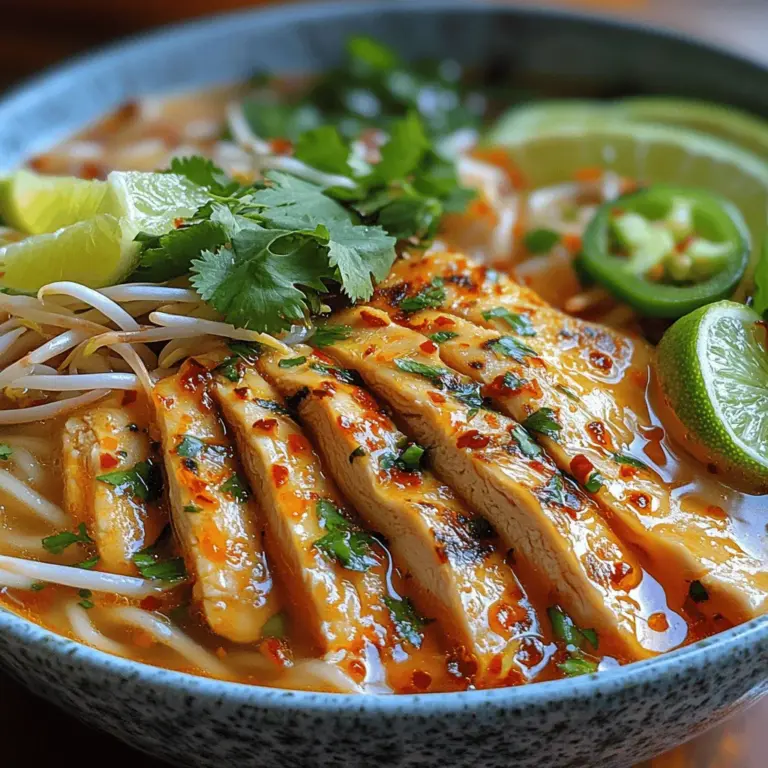Introduction
Fragrant Lemongrass Chicken Pho is a delightful twist on the classic Vietnamese noodle soup, renowned for its aromatic broth and vibrant flavors. This dish combines succulent chicken with fresh herbs, spices, and rice noodles, creating a wholesome and satisfying meal that’s perfect for any occasion. Pho, traditionally enjoyed as a breakfast dish in Vietnam, has gained immense popularity globally, making its way into homes and restaurants alike. The warmth of the broth, paired with the tangy notes of lemongrass and the heat from chili, makes this dish an unforgettable culinary experience.
In the realm of culinary blogging, sharing recipes like Fragrant Lemongrass Chicken Pho is not just about food; it’s about storytelling and connecting with readers. Each recipe carries its own narrative, reflecting culture, tradition, and the joy of cooking. By sharing this recipe, we foster a community of food lovers, encouraging experimentation and exploration in the kitchen.
The flavor profile of this dish is what sets it apart. The lemongrass adds a citrusy brightness, while the chicken provides a hearty base. Fresh herbs such as cilantro and basil contribute a fragrant aroma, and the rice noodles offer a comforting texture. Together, these elements create a balance of flavors that tantalize the palate and leave you craving more.
Understanding the Ingredients
To create an authentic and flavorful bowl of Fragrant Lemongrass Chicken Pho, it’s essential to understand the key ingredients that make this dish shine.
Fresh Produce: Vegetables and Herbs
Fresh produce plays a crucial role in enhancing the flavors of pho. The following ingredients are commonly used:
– Lemongrass: This is the star ingredient of the dish, providing a refreshing citrus flavor. When selecting lemongrass, look for stalks that are firm and free of blemishes. The outer leaves should be green and not dried out.
– Onions: Typically, yellow or white onions are used in pho. They add sweetness and depth to the broth. Grilled or charred onions are often used to intensify their flavor.
– Ginger: Fresh ginger adds warmth and spice to the broth. When using ginger, opt for firm, smooth pieces, free of wrinkles or blemishes.
– Fresh herbs: Herbs such as cilantro, Thai basil, and mint are essential for garnishing the dish. They add complexity and freshness, balancing the savory elements of the soup.
Proteins: Types and Their Benefits
The choice of protein can significantly influence the overall flavor and texture of your pho. For this recipe, we focus on chicken, but other proteins can be used based on preference:
– Chicken: Boneless, skinless chicken thighs or breasts are ideal for their tender texture. Chicken thighs offer more flavor due to their fat content, making them a popular choice for pho.
– Tofu: For a vegetarian option, firm tofu can be marinated and added to the broth, providing a protein-rich alternative.
– Seafood: Shrimp or fish can also be used to create a seafood version of pho, offering a different flavor profile.
Grains or Starches: Variations and Substitutions
The type of noodle used in pho is essential for achieving the right texture:
– Rice Noodles: Flat rice noodles are the traditional choice for pho. They are gluten-free and cook quickly, absorbing the broth’s flavors. When shopping for rice noodles, look for fresh or dried variants, depending on availability.
– Substitutes: If you’re looking for alternatives, consider spiralized vegetables like zucchini or shirataki noodles for a low-carb option. However, keep in mind that this will change the overall experience of the dish.
Importance of Ingredient Quality
The quality of ingredients directly impacts the flavor and authenticity of your pho. Fresh, high-quality produce yields a more aromatic and flavorful broth. Whenever possible, source ingredients from local markets or farmers’ markets to ensure freshness. Organic produce is also recommended, as it tends to have a more robust flavor.
Seasonal Considerations for Ingredient Selection
Seasonality can play a significant role in the ingredients you choose. For instance, lemongrass is typically available year-round in many regions, but the peak season can enhance its flavor. Similarly, using fresh herbs that are in season will provide maximum flavor and aroma. Consider adapting your recipe based on what’s available, ensuring the freshest and most vibrant ingredients make it into your bowl.
Preparation Steps
Preparation is key to achieving a successful bowl of Fragrant Lemongrass Chicken Pho. Taking the time to properly prepare your ingredients will ensure a smooth cooking process and a delicious outcome.
Detailed Preparation Process
1. Cleaning and Chopping Vegetables:
– Start by thoroughly washing your vegetables. For lemongrass, remove the tough outer layers to reveal the tender inside. Slice the stalks into thin rounds to maximize flavor extraction in the broth.
– Peel and thinly slice the onions and ginger. If desired, you can char the onion and ginger directly over an open flame or in a skillet to enhance their flavor.
2. Prepping Proteins: Marination and Seasoning:
– For chicken, consider marinating it with a mixture of fish sauce, soy sauce, and a touch of sugar for at least 30 minutes. This will infuse the meat with flavor and keep it juicy during cooking.
– If using tofu, press it to remove excess moisture, then cube and marinate similarly to the chicken for enhanced flavor.
3. Cooking Grains or Starches: Methods and Timing:
– Prepare the rice noodles according to package instructions. Typically, this involves soaking dried noodles in hot water until tender, then draining and rinsing them to prevent sticking.
4. Tips for Efficient Preparation:
– Organize your workspace and ingredients before you start cooking. This practice, known as mise en place, helps streamline the cooking process and ensures you have everything at hand.
5. Importance of Mise en Place:
– Having all your ingredients prepped and ready to go will not only speed up your cooking time but also reduce the likelihood of missing an essential step.
Cooking Techniques
Cooking techniques are vital to achieving the perfect bowl of pho. Each method contributes to the dish’s overall flavor and presentation.
Overview of Cooking Methods Used in the Recipe
– Sautéing: This method is often used for aromatics. Sautéing the onions and ginger in a bit of oil before adding the broth helps to release their natural oils and deepen their flavors.
– Roasting: Roasting the chicken (if you choose to do so) can enhance its flavor. This method caramelizes the exterior, creating a rich and savory crust that adds depth to the soup.
– Boiling or Steaming Grains: Cooking the rice noodles requires careful timing to achieve the perfect texture. Be mindful not to overcook them, as they should remain al dente to hold up well in the broth.
The Role of Heat Management in Cooking
Understanding how to manage heat is crucial. A gentle simmer is ideal for the broth, allowing the flavors to meld without boiling, which can make the broth cloudy. For sautéing, medium heat is typically best to avoid burning the ingredients while still allowing them to cook through.
How to Layer Flavors Through Cooking Techniques
Layering flavors is essential in creating a complex and satisfying broth. Start with sautéing your aromatics, then add your broth and proteins. Allow the chicken to cook in the simmering broth, absorbing the flavors from the herbs and spices. This technique ensures that every component contributes to the final taste of the dish, resulting in a rich and fragrant bowl of pho.
Flavor Enhancements
To amplify the flavor of your Fragrant Lemongrass Chicken Pho, consider incorporating various spices and herbs.
Incorporating Spices and Herbs
– Star Anise: This spice adds a warm, sweet flavor that complements the broth beautifully. Be cautious with the amount; a little goes a long way.
– Cinnamon: A small stick of cinnamon can enhance the depth of flavor in your broth, marrying well with the other spices.
– Cloves: Whole cloves add a unique warmth and sweetness, but like star anise, should be used sparingly.
– Chili Peppers: For those who enjoy heat, sliced fresh chili peppers or dried chili flakes can be added to the broth or served as a garnish.
Recommended Spices for This Recipe
Experiment with the amount of each spice based on your personal preference and tolerance for heat. The balance of flavors is key to creating a comforting and aromatic pho that will leave a lasting impression on anyone fortunate enough to enjoy it.
With these guidelines and techniques in mind, you’re well on your way to creating a delicious bowl of Fragrant Lemongrass Chicken Pho that will warm both your heart and your stomach. Continue preparing with care and attention to detail, and soon you’ll be ready to serve up this delightful dish.

Fresh vs. Dried Herbs: When to Use Each
In crafting the perfect bowl of Fragrant Lemongrass Chicken Pho, the choice between fresh and dried herbs can significantly influence the overall flavor profile. Fresh herbs, such as cilantro, basil, and mint, are vibrant and aromatic, lending a bright and zesty quality to the dish. They are best used as garnishes or added during the final moments of cooking to maintain their essential oils and freshness.
On the other hand, dried herbs possess a concentrated flavor, making them ideal for infusing broths and sauces during the cooking process. In this recipe, while dried herbs may be used to build the foundation of flavor in the broth, it is highly recommended to finish with a handful of fresh herbs to achieve that aromatic punch typical of traditional pho. The balance of both types of herbs can elevate your dish, creating a more complex and flavorful experience.
Balancing Flavors: Sweet, Salty, Sour, and Bitter
Achieving the perfect balance of flavors is crucial in Vietnamese cuisine, particularly in a dish as nuanced as pho. The essential elements of flavor include sweet, salty, sour, and bitter, each playing a pivotal role in creating the harmonious taste that defines this beloved soup.
1. Sweet: Incorporate natural sweetness through the addition of onions or a touch of rock sugar. This sweetness helps to round out the sharper flavors and creates a more approachable broth.
2. Salty: Fish sauce is a traditional ingredient in pho, providing essential umami and saltiness. Use it judiciously to enhance the depth of flavor without overpowering the dish.
3. Sour: Fresh lime juice is crucial for that bright, tangy punch. Adding lime enhances the freshness of the dish and balances the richness of the chicken and broth.
4. Bitter: While not a dominant flavor in pho, a hint of bitterness can be introduced through herbs like Thai basil or even the charred elements of the broth from roasted spices.
The key to mastering these flavors is to taste and adjust as you go. Start with small additions of each element and remember that you can always add more, but it’s challenging to correct an imbalance once it’s been established.
Importance of Tasting and Adjusting Seasoning
One of the most critical steps in cooking is tasting your food as you go. This practice is especially vital when making pho, as the flavors develop and change throughout the cooking process. During the simmering phase, periodically taste the broth to identify any areas where it may need more salt, sweetness, or acidity.
If it tastes too salty, a splash of water or more lime juice can help. Conversely, if the flavors are muted, consider adding a pinch more fish sauce or a bit of sugar to enhance sweetness. The beauty of cooking lies in adjusting flavors to suit your palate, so don’t hesitate to make these adjustments until you achieve the desired taste.
Serving Suggestions
When it comes to serving your Fragrant Lemongrass Chicken Pho, presentation is key. Here are some ideas to enhance the visual appeal and overall dining experience:
– Presentation Ideas: Use a large, shallow bowl to serve the pho, allowing the fragrant broth and vibrant garnishes to take center stage. Layer the chicken and noodles artistically, and don’t shy away from a generous sprinkle of fresh herbs on top.
– Complementary Sides or Accompaniments: Consider serving your pho with a side of spring rolls or banh mi for a delightful contrast of textures. These options not only complement the flavors of the soup but also provide a satisfying meal.
– Salad Pairings: A side salad of shredded cabbage, carrots, and herbs dressed in a light lime vinaigrette can provide a refreshing crunch that balances the rich broth.
– Bread or Rice Options: For those who enjoy a more filling meal, serve the pho with a side of crusty baguette or steamed jasmine rice to soak up the flavorful broth.
– Beverage Pairings: Pair your pho with a light, refreshing beverage such as iced jasmine tea, coconut water, or a crisp lager. These drinks will enhance the meal without overwhelming the palate.
Nutritional Profile
Fragrant Lemongrass Chicken Pho is not only delicious but also packed with nutritional benefits. Here’s a breakdown of what makes this dish a wholesome choice:
– Protein Source: Chicken provides a lean source of protein, essential for muscle repair and growth. Opt for skinless chicken breast for a healthier option, or use thighs for added flavor.
– Vitamins and Minerals: Fresh herbs and vegetables are rich in vitamins A and C, contributing to overall health. The addition of lime juice provides a boost of vitamin C, which is excellent for immune support.
– Low-Calorie Option: Pho can be a low-calorie meal, especially when made with broth and plenty of vegetables. The use of rice noodles rather than heavier pastas keeps the dish light.
– Dietary Considerations: Pho can easily be adapted for various dietary needs. For a vegan version, substitute chicken with tofu or mushrooms and use vegetable broth. For gluten-free options, choose rice noodles that are certified gluten-free.
Cultural Context
Pho is much more than just a dish; it is a symbol of Vietnamese culture and heritage. Originating from the early 20th century in Northern Vietnam, pho gained popularity due to its comforting qualities and the balance of flavors it offers. Traditionally, it was a street food, enjoyed by locals and travelers alike, and has since spread across the globe, becoming a beloved staple in many countries.
Variations of pho exist in different regions of Vietnam, with the southern style typically featuring a sweeter broth and additional garnishes like bean sprouts and lime. The northern version tends to be more straightforward, focusing on the clear broth and fewer toppings. These variations reflect the diverse culinary landscape of Vietnam and the adaptability of pho to various tastes and preferences.
Common Mistakes to Avoid
To ensure your pho turns out perfectly, keep these common mistakes in mind:
– Incorrect Cooking Times and Temperatures: Overcooking the broth can lead to bitterness, while undercooking the noodles can result in an unpleasant texture. Follow the timing closely for the best results.
– Overcomplicating the Recipe: While it’s tempting to add many ingredients, simplicity is key. Focus on high-quality ingredients and allow their natural flavors to shine through.
– Neglecting Ingredient Quality: Freshness is paramount in pho. Using wilted herbs or stale noodles can significantly diminish the dish’s quality. Always opt for the freshest ingredients available.
Variations and Customizations
One of the joys of cooking is the ability to customize recipes to fit your taste. Here are some suggestions for adapting your Fragrant Lemongrass Chicken Pho:
– Ingredient Swaps: Substitute chicken with beef, shrimp, or even a variety of vegetables for a vegetarian or vegan option. Each protein brings its unique flavor to the broth.
– Dietary Needs: For those watching their carb intake, consider using zucchini noodles or shirataki noodles as a low-carb alternative to traditional rice noodles.
– Reinventing Leftovers: If you have leftover broth, consider turning it into a noodle stir-fry or using it as a base for a soup with other proteins and vegetables.
Conclusion
Fragrant Lemongrass Chicken Pho is not just a meal; it’s an experience that brings warmth and comfort. The aromatic broth, tender chicken, and fresh herbs come together to create a dish that is both satisfying and versatile. As you explore the nuances of this recipe, take the time to enjoy the process of cooking and sharing meals with loved ones. Whether you’re following the recipe to the letter or adding your unique twist, the joy of creating something delicious is what makes cooking truly special. Embrace the flavors, savor the moments, and most importantly, let your creativity shine in the kitchen.

